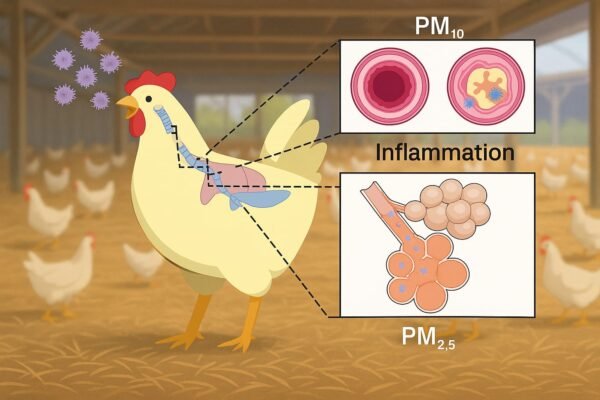Fine particulate matter in poultry houses and its impact on respiratory diseases

Dr. Majed Hamed Al Saegh / poultry pathologist / Australia
Title: Fine particulate matter in poultry houses and its impact on respiratory diseases: A systematic review
Abstract
Fine particulate matter (PM) is a major environmental stressor in the global poultry industry. Due to its large surface area, PM can carry various pollutants such as ammonia, heavy metals, and pathogens. High concentrations of PM can lead to respiratory inflammation and a range of diseases in poultry. This review discusses the potential mechanisms by which PM affects respiratory health, including oxidative stress, microbiome disruption, immunosuppression, and ammonia toxicity. It also highlights the sources and composition of PM in poultry houses and provides recommendations for future research and monitoring.
Keywords: Fine particulate matter, poultry houses, respiratory diseases, inflammation, microbiome, PM2.5
1. Introduction
Respiratory diseases in poultry are significantly influenced by indoor air quality. According to Bryan (1996), more than 90% of lung diseases are initiated or exacerbated by inhalation of particulate matter and gases. Poultry house environments differ from outdoor environments due to the high levels of particulate matter emitted from feed, feathers, bedding, droppings, and skin cells. Particles may be concentrated internally at 10 to 100 times higher than outdoor levels. PM10 particles reach the upper respiratory tract, while PM2.5 particles penetrate deep into the lungs.
The effects of particulate matter are exacerbated by high humidity and temperature, which facilitate the adhesion of microbes and metabolic byproducts. The unique respiratory anatomy of birds (particularly the presence of air sacs) makes birds more susceptible to airborne pollutants. However, the precise mechanisms of particulate matter’s health effects remain poorly understood.
2. Sources and Composition of Fine Particles
Particles originate from feathers, bedding, urine crystals, and waste. Litter-based systems generate more particulate matter than litter-free systems. The main chemical elements include carbon, oxygen, nitrogen, phosphorus, sulfur, sodium, calcium, aluminum, magnesium, and potassium. Particulate matter composition varies depending on the bird species, management system, environmental control, season, and bird activity. Broiler chickens produce more particulate matter with age due to increased feather shedding and drying of manure. Feeding and lighting activities also increase particulate matter levels by stirring up settled dust.
3. Health Risks of Particulate Matter to the Respiratory System
Particulate matter affects respiratory health through three main pathways:
• Direct inhalation, causing respiratory tract irritation.
• Toxic compounds (such as ammonia), which induce inflammation and immune dysfunction.
• Microorganisms and endotoxins carried on particles, which lead to infection and immune activation.
PM10 particles reach the lower respiratory tract in adult birds, while PM1 particles affect newly hatched chicks. Histological studies show bronchial lesions, damage to the tracheal mucosa, and immune changes. Inflammatory markers also increase with exposure to particulate matter, and pro-immunomodulatory components (PAMPs) in particulate matter enhance immune responses and alter cardiac physiology.
4. Ammonia Toxicity in Particulate Matter
Ammonia is a cardiotoxic gas common in poultry houses, especially in winter with poor ventilation. It binds to PM2.5 to enhance its toxicity. It degrades mucosal barriers, disrupts immune balance, activates the NF-κB pathway, and induces apoptosis. Studies show increased reactive oxygen species (ROS), decreased antioxidants, and altered gene expression in respiratory tissues.
5. Microbial and Endotoxin Hazards
Particulate matter carries bacteria, fungi, and endotoxins that cause respiratory infections, allergies, and immunotoxicity. Pathogens include Chlamydia, Staphylococcus aureus, Listeria, Streptococcus, and Salmonella. Fungal spores (such as Aspergillus and Fusarium) contribute to pneumonia. Lipopolysaccharides (LPS) from Gram-negative bacteria activate TLR4-CD14 receptors, stimulating cytokine release and lung damage. Mycotoxins also exacerbate respiratory and immune disorders.
6. Molecular Mechanisms of Particulate Matter-Induced Inflammation
a) Alveolar Macrophage-Reactive Oxygen Species (ROS) Pathway: PM2.5 activates macrophages to secrete pro-inflammatory cytokines, stimulates redox-sensitive pathways (MAPKs, PI3K/Akt), and causes oxidative stress. Activation of genes (such as NLRP3, RIPK3) leads to inflammation and proinflammatory cell death (pyroptosis). Calcium release from the endoplasmic reticulum enhances NF-κB signaling.
b) TLR4-NF-κB Pathway: PM2.5 activates TLR4, which enhances NF-κB and increases levels of interleukin-6, interleukin-8, and tumor necrosis factor-α (TNF-α). Nrf2 helps reduce inflammation by decreasing oxidative stress. MyD88 and TRIP mediate subsequent signals.
7. Microbiome Disruption and Microbiome-Metabolite Interactions
Exposure to particulate matter disrupts the lung and gut microbiome, causing immune and metabolic imbalances. Microbiome-metabolite studies reveal strong links between microbial changes and lung injury. PM2.5 increases susceptibility to respiratory pathogens such as Streptococcus pneumoniae. Probiotics have shown potential to restore microbial balance and reduce inflammation.

8. Conclusion
With the expansion of intensive poultry farming, exposure to particulate matter has become inevitable. PM2.5 impairs respiratory health through microbial colonization, immune activation, oxidative stress, and metabolic imbalance. The severity depends on the particle concentration, its components, and housing conditions. Particulate matter-associated respiratory diseases cause significant economic losses. Monitoring PM2.5 levels and identifying toxic constituents is essential to improving poultry health and productivity.
Recommendations
1. Implement continuous PM2.5 monitoring.
2. Improve ventilation, humidity control, and litter management.
3. Use antioxidants and probiotics.
4. Conduct studies.
5. Integrate animal welfare into barn design.



